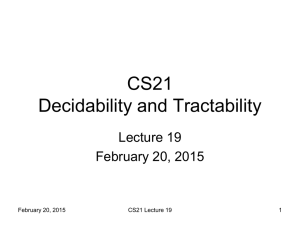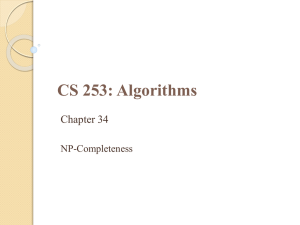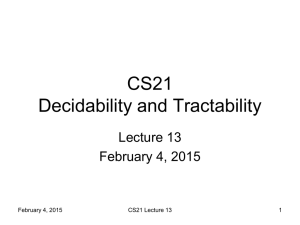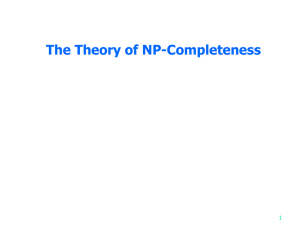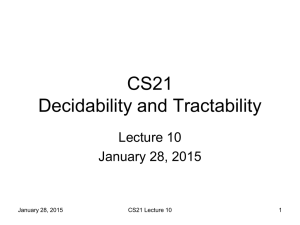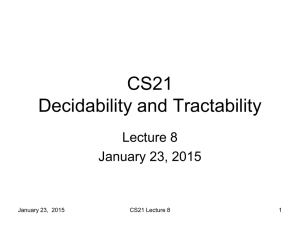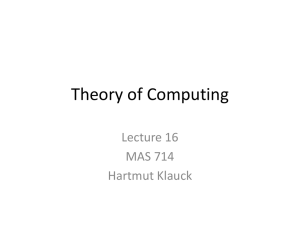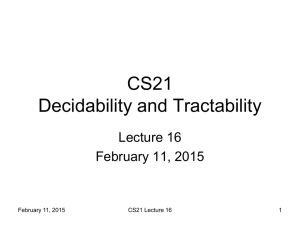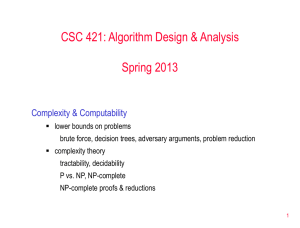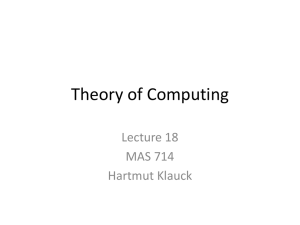CS21 Lecture 1
advertisement
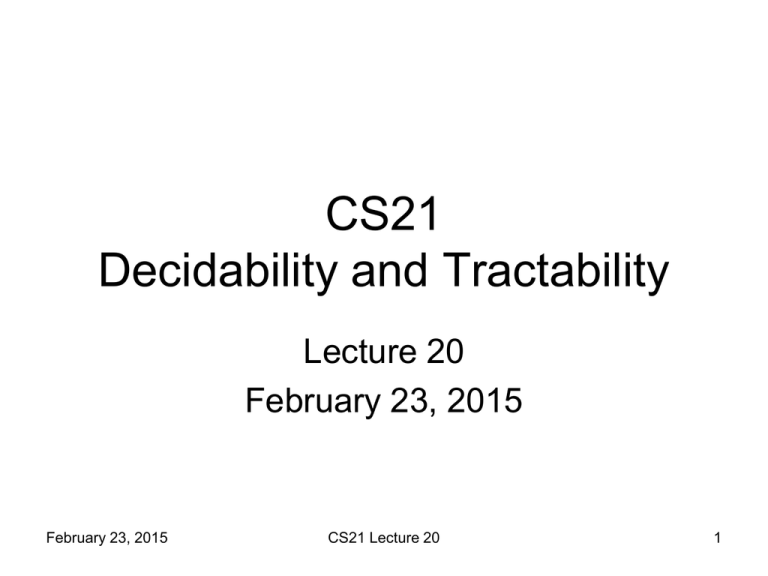
CS21
Decidability and Tractability
Lecture 20
February 23, 2015
February 23, 2015
CS21 Lecture 20
1
Outline
• the class NP
– 3-SAT is NP-complete (finishing up)
– NP-complete problems: independent set,
vertex cover, clique
– NP-complete problems: Hamilton path and
cycle,Traveling Salesperson Problem
February 23, 2015
CS21 Lecture 20
2
CIRCUIT-SAT is NP-complete
Theorem: CIRCUIT-SAT is NP-complete
CIRCUIT-SAT = {C : C is a Boolean circuit for
which there exists a satisfying truth assignment}
Proof:
– Part 1: need to show CIRCUIT-SAT NP.
• can express CIRCUIT-SAT as:
CIRCUIT-SAT = {C : C is a Boolean circuit for
which x such that (C, x) R}
R = {(C, x) : C is a Boolean circuit and C(x) = 1}
February 23, 2015
CS21 Lecture 20
3
CIRCUIT-SAT is NP-complete
CIRCUIT-SAT = {C : C is a Boolean circuit for
which there exists a satisfying truth assignment}
Proof:
– Part 2: for each language A NP, need to
give poly-time reduction from A to CIRCUIT-SAT
– for a given language A NP, we know
A = {x | 9 y, |y| ≤ |x|k, (x, y) R }
and there is a (deterministic) TM MR that
decides R in time g(n) ≤ nc for some c.
February 23, 2015
CS21 Lecture 20
4
3SAT is NP-complete
Theorem: 3SAT is NP-complete
3SAT = {φ : φ is a 3-CNF formula for which there
exists a satisfying truth assignment}
Proof:
– Part 1: need to show 3-SAT NP
• already done
– Part 2: need to show 3-SAT is NP-hard
• we will give a poly-time reduction from
CIRCUIT-SAT to 3-SAT
February 23, 2015
CS21 Lecture 20
5
3SAT is NP-complete
– given a circuit C
• variables x1, x2, …, xn
• AND (), OR (), NOT () gates g1, g2, …, gm
– reduction f(C) produces these clauses for φ
on variables x1, x2, …, xn, g1, g2, …, gm:
gi
z
February 23, 2015
• (gi z)
• (z gi)
CS21 Lecture 20
(z gi)
6
3SAT is NP-complete
– given a circuit C
• variables x1, x2, …, xn
• AND (), OR (), NOT () gates g1, g2, …, gm
– reduction f(C) produces these clauses for φ
on variables x1, x2, …, xn, g1, g2, …, gm:
• (z1 gi)
gi
z1
February 23, 2015
• (z2 gi)
z2
• (gi z1 z2)
CS21 Lecture 20
(z1 z2
gi)
7
3SAT is NP-complete
– given a circuit C
• variables x1, x2, …, xn
• AND (), OR (), NOT () gates g1, g2, …, gm
– reduction f(C) produces these clauses for φ
on variables x1, x2, …, xn, g1, g2, …, gm:
• (gi z1)
gi
z1
February 23, 2015
• (gi z2)
z2
• (z1 z2 gi)
CS21 Lecture 20
(z1 z2
gi)
8
3SAT is NP-complete
– finally, reduction f(C) produces single clause
(gm) where gm is the output gate.
– f(C) computable in poly-time?
• yes, simple transformation
– YES maps to YES?
• if C(x) = 1, then assigning x-values to xvariables of φ and gate values of C when
evaluating x to the g-variables of φ gives
satsifying assignment.
February 23, 2015
CS21 Lecture 20
9
3SAT is NP-complete
– NO maps to NO?
• show that φ satisfiable implies C satisfiable
• satisfying assignment to φ assigns values
to x-variables and g-variables
• output gate gm must be assigned 1
• every other gate must be assigned value it
would take given values of its inputs.
• the assignment to the x-variables must be a
satisfying assignment for C.
February 23, 2015
CS21 Lecture 20
10
Search vs. Decision
• Definition: given a graph G = (V, E), an
independent set in G is a subset V’ V
such that for all u,w V’ (u,w) E
• A problem:
given G, find the largest independent set
• This is called a search problem
– searching for optimal object of some type
– comes up frequently
February 23, 2015
CS21 Lecture 20
11
Search vs. Decision
• We want to talk about languages (or
decision problems)
• Most search problems have a natural,
related decision problem by adding a
bound “k”; for example:
– search problem: given G, find the largest
independent set
– decision problem: given (G, k), is there an
independent set of size at least k
February 23, 2015
CS21 Lecture 20
12
Ind. Set is NP-complete
Theorem: the following language is NPcomplete:
IS = {(G, k) : G has an IS of size k}.
• Proof:
– Part 1: IS NP. Proof?
– Part 2: IS is NP-hard.
• reduce from 3-SAT
February 23, 2015
CS21 Lecture 20
13
Ind. Set is NP-complete
• We are reducing from the language:
3SAT = { φ : φ is a 3-CNF formula that has a
satisfying assignment }
to the language:
IS = {(G, k) : G has an IS of size k}.
February 23, 2015
CS21 Lecture 20
14
Ind. Set is NP-complete
The reduction f: given
φ = (x y z) (x w z) … (…)
we produce graph Gφ:
x
x
y
z w
…
z
• one triangle for each of m clauses
• edge between every pair of contradictory literals
• set k = m
February 23, 2015
CS21 Lecture 20
15
Ind. Set is NP-complete
φ = (x y z) (x w z) … (…)
f(φ) =
(G, # clauses)
x
y
x
z w
…
z
• Is f poly-time computable?
• YES maps to YES?
– 1 true literal per clause in satisfying assign. A
– choose corresponding vertices (1 per triangle)
– IS, since no contradictory literals in A
February 23, 2015
CS21 Lecture 20
16
Ind. Set is NP-complete
φ = (x y z) (x w z) … (…)
f(φ) =
(G, # clauses)
x
y
x
z w
…
z
• NO maps to NO?
– IS can have at most 1 vertex per triangle
– IS of size # clauses must have exactly 1 per
– since IS, no contradictory vertices
– can produce satisfying assignment by setting
these literals to true
February 23, 2015
CS21 Lecture 20
17
Vertex cover
• Definition: given a graph G = (V, E), a
vertex cover in G is a subset V’ V such
that for all (u,w) E, u V’ or w V’
• A search problem:
given G, find the smallest vertex cover
• corresponding language (decision problem):
VC = {(G, k) : G has a VC of size ≤ k}.
February 23, 2015
CS21 Lecture 20
18
Vertex Cover is NP-complete
Theorem: the following language is NPcomplete:
VC = {(G, k) : G has a VC of size ≤ k}.
• Proof:
– Part 1: VC NP. Proof?
– Part 2: VC is NP-hard.
• reduce from?
February 23, 2015
CS21 Lecture 20
19
Vertex Cover is NP-complete
• We are reducing from the language:
IS = {(G, k) : G has an IS of size k}
to the language:
VC = {(G, k) : G has a VC of size ≤ k}.
February 23, 2015
CS21 Lecture 20
20
Vertex Cover is NP-complete
• How are IS, VC related?
• Given a graph G = (V, E) with n nodes
– if V’ V is an independent set of size k
– then V-V’ is a vertex cover of size n-k
• Proof:
– suppose not. Then there is some edge with
neither endpoint in V-V’. But then both
endpoints are in V’. contradiction.
February 23, 2015
CS21 Lecture 20
21
Vertex Cover is NP-complete
• How are IS, VC related?
• Given a graph G = (V, E) with n nodes
– if V’ V is a vertex cover of size k
– then V-V’ is an independent set of size n-k
• Proof:
– suppose not. Then there is some edge with
both endpoints in V-V’. But then neither
endpoint is in V’. contradiction.
February 23, 2015
CS21 Lecture 20
22
Vertex Cover is NP-complete
The reduction:
– given an instance of IS: (G, k) f produces the
pair (G, n-k)
• f poly-time computable?
• YES maps to YES?
– IS of size k in G VC of size ≤ n-k in G
• NO maps to NO?
– VC of size ≤ n-k in G IS of size k in G
February 23, 2015
CS21 Lecture 20
23
Clique
• Definition: given a graph G = (V, E), a
clique in G is a subset V’ V such that for
all u,v V’, (u, v) E
• A search problem:
given G, find the largest clique
• corresponding language (decision problem):
CLIQUE = {(G, k) : G has a clique of size k}.
February 23, 2015
CS21 Lecture 20
24
Clique is NP-complete
Theorem: the following language is NPcomplete:
CLIQUE = {(G, k) : G has a clique of size k}
• Proof:
– Part 1: CLIQUE NP. Proof?
– Part 2: CLIQUE is NP-hard.
• reduce from?
February 23, 2015
CS21 Lecture 20
25
Clique is NP-complete
• We are reducing from the language:
IS = {(G, k) : G has an IS of size k}
to the language:
CLIQUE = {(G, k) : G has a CLIQUE of size k}.
February 23, 2015
CS21 Lecture 20
26
Clique is NP-complete
• How are IS, CLIQUE related?
• Given a graph G = (V, E), define its complement
G’ = (V, E’ = {(u,v) : (u,v) E})
– if V’ V is an independent set in G of size k
– then V’ is a clique in G’ of size k
• Proof:
– Every pair of vertices u,v 2 V’ has no edge between
them in G. Therefore they have an edge between
them in G’.
February 23, 2015
CS21 Lecture 20
27
Clique is NP-complete
• How are IS, CLIQUE related?
• Given a graph G = (V, E), define its complement
G’ = (V, E’ = {(u,v) : (u,v) E})
– if V’ V is a clique in G’ of size k
– then V’ is an independent set in G of size k
• Proof:
– Every pair of vertices u,v 2 V’ has an edge between
them in G’. Therefore they have no edge between
them in G.
February 23, 2015
CS21 Lecture 20
28
Clique is NP-complete
The reduction:
– given an instance of IS: (G, k) f produces the
pair (G’, k)
• f poly-time computable?
• YES maps to YES?
– IS of size k in G CLIQUE of size k in G’
• NO maps to NO?
– CLIQUE of size k in G’ IS of size k in G
February 23, 2015
CS21 Lecture 20
29
Hamilton Path
• Definition: given a directed graph G = (V,
E), a Hamilton path in G is a directed path
that touches every node exactly once.
• A language (decision problem):
HAMPATH = {(G, s, t) : G has a Hamilton path
from s to t}
February 23, 2015
CS21 Lecture 20
30
HAMPATH is NP-complete
Theorem: the following language is NPcomplete:
HAMPATH = {(G, s, t) : G has a Hamilton path
from s to t}
• Proof:
– Part 1: HAMPATH NP. Proof?
– Part 2: HAMPATH is NP-hard.
• reduce from?
February 23, 2015
CS21 Lecture 20
31
HAMPATH is NP-complete
• We are reducing from the language:
3SAT = { φ : φ is a 3-CNF formula that has a
satisfying assignment }
to the language:
HAMPATH = {(G, s, t) : G has a Hamilton path
from s to t}
February 23, 2015
CS21 Lecture 20
32
HAMPATH is NP-complete
• We want to construct a graph from φ with
the following properties:
– a satisfying assignment to φ translates into a
Hamilton Path from s to t
– a Hamilton Path from s to t can be translated
into a satisfying assignment for φ
• We will build the graph up from pieces
called gadgets that “simulate” the clauses
and variables of φ.
February 23, 2015
CS21 Lecture 20
33
HAMPATH is NP-complete
• The variable gadget (one for each xi):
xi true:
…
…
…
xi false:
February 23, 2015
CS21 Lecture 20
34
HAMPATH is NP-complete
s
…
“x1”
…
“x2”
…
• why must
the path be of
“xm” this form?
:
February 23, 2015
t
CS21 Lecture 20
• path from s
to t translates
into a truth
assignment
to x1…xm
35

